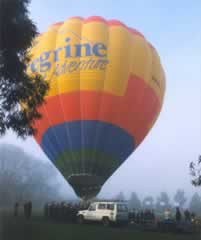|
Internal
combustion engine
|
| Powered flight is
made possible by the chemical reactions harnessed to release heat and gas.
A physical law known as Newton's 3rd Law of Motion also makes motion, especially
flight, possible. |
| Hot air balloons
use hot air in a total different manner to a propeller, jet plane or even
a rocket. Hot air is less dense than normal air so it will rise in the cold
morning air much like an air bubble rises in a container of water. A balloon
filled with hot air is lighter than the surrounding air so it rises. Nowadays
this form of travel is limited to recreational uses and has little commercial
benefit. |
|
| With the advent
of the internal combustion engine things started to rev-up in the field
of aviation. In the internal combustion engine fuel is mixed with oxygen
and ignited to create a mini explosion inside a small confined space (cylinder)
with a movable platform (piston). Vertical motion is converted into rotational
motion which spins a propeller. This rotational motion is put to good use
spinning a propeller. The propeller sucks in air and pushes it out the back
towards the rear of the plane. |
 |
The
force with which the air is pushed back creates an equal and opposite force
pushing the plane forwards. Newton's Third Law of Motion states that
"For every action there is an equal and opposite reaction".
Click for an introduction to forces. |
 |
| So
in order to make the plane fly faster we have to increase the force (action)
of the air being pushed back. This will create an equal force acting in
the opposite direction pushing the plane forwards known as the reaction.
Engineers constantly struggled to increase the power of the propeller engine.
The Spitfire and Hurricane were two of the most powerful planes during WW
II powered by a Rolls-Royce Merlin engine. Speeds in excess of 600 km/hr
were reached and gave these planes a superior advantage during battle. |
|
The energy to power the engine
comes from the fuel. It is stored as chemical potential energy. The engine
turns chemical energy (fuel) into kinetic energy (motion energy). Click
for a quick lesson on energy conversion.
Energy can not be created or destroyed it can only change in form. This
is known as the law of conservation of energy. In a typical internal combustion
energy approximately 25% of the chemical potential energy is converted
into useful kinetic energy. The other 75% is lost mainly as heat energy
and sound energy.
|
|
|


